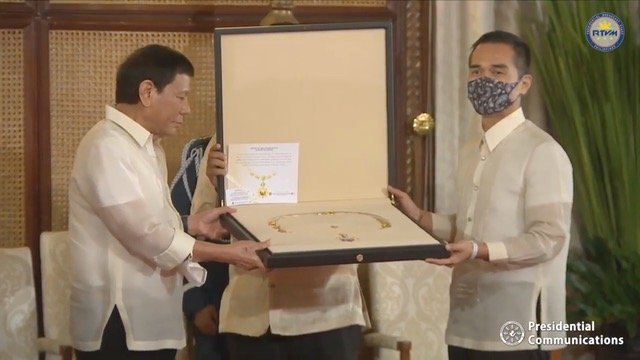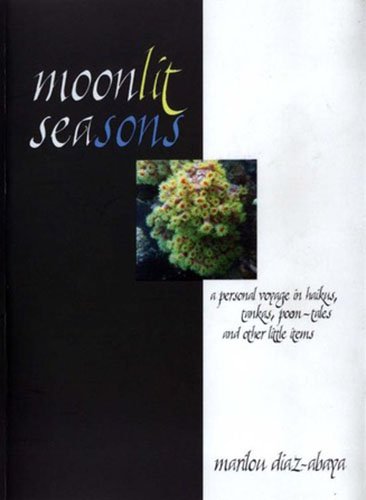Marilou Diaz-Abaya: Portrait of the Filipina as Filmmaker
/Marc Abaya (representing his mother Marilou Diaz-Abaya) in Malacañang with President Duterte giving him the medallion as National Artist for Film and Broadcast Arts (Source: Presidential Communications)
Her works from Brutal to Karnal from Jose Rizal to Muro-Ami up to Sa Pusod ng Dagat and Milagros speak for themselves.
Indeed, she was into film not to make money but to refract art and life into her personal looking lens. Sa Pusod Ng Dagat, Muro-Ami, and Jose Rizal are an excellent trilogy of Abaya’s output.
Moreover, Abaya’s Milagros is indeed existential, and it shows that Abaya was one of the original indie filmmakers whose mainstream films don’t always conform to the tried-and-tested commercial formula.
Sa Pusod Ng Dagat is Abaya’s tribute to the sea, and it is amazing how the film flows spontaneously like the life cycle in the rural areas. The inhabitants are virtual captives of the island they consider home. To most, this is where they are going to live and die.
It is refreshing to see the village comadrona taken over by a young man (Joemari Yllana), who narrates his idyllic beginning in this village by the sea. The film ends with a shot of him being trailed by children whose birth he has facilitated and witnessed.
Muro-Ami – like Sa Pusod ng Dagat --is another tale by the sea. Viewed many times with reruns on television, it remains a quiet but symbolic exploration of the deep, blue sea, its latent power, its bottomless mystery, and how its cycle relates to human life.
Marilou Diaz-Abaya with Cesar Montano and Amy Austria in the set of the film Muro-Ami.
In the last few years of her life, Abaya remained a consummate artist.
She found time to write her last book, The Moonlit SEAsons. It is one book recommended for lovers of film who want to go deep into the art and life of Abaya.
Published in 2009 some three years before her death. Moonlit SEAsons is the filmmaker’s foray into literature as well as her last diary when she was diagnosed with cancer in 2007.
Marilou’s Moonlit SEAsons
In the 187-page book designed by Dani Mojica, Abaya shares with her readers her fascination with nature and the world beyond Planet Earth.
Specifically, she expounds on her admiration for Japanese art and culture, her obsession with the moon and the sea, and how her future film projects were dictated by this fascination. It led to her writing very personal essays and dabbling in poetry, notably in the genre of haiku, tanka, and poem-tales.
She admits poetry evoked intuitive experience impossible to film. Understandably, she pays tribute to the sea in the opening haikus thus:
a coral garden
deep inside my mother’s womb
In the dark, spawning
white tops on blue bay
windsurfers in pas de deux
Oh sweet amihan
choirs of angelfish
Beethoven’s Ninth symphonydiver’s cathedral
A curious essay on her friends Ishmael Bernal and Rolando Tinio, called Two Navels, is a clue that the filmmaker is all set to join her friends some three years before her death (the book was written in 2009).
She recalls that Bernal and Tinio also loved the outdoor in unusual ways. Rolando couldn’t swim but loved the sea. Ishmael was a trained diver but preferred to climb the Rocky Mountains. “They have gone ahead beyond the visible horizons of this earth, leaving me behind with souvenirs of their Life as Art.”
When Tinio passes away and she is mourning his death, Abaya wonders if her own (death) will be as blessed and peaceful:
farewells by the sea
now in far horizon
moon sets agony
siren lowered to her grave
lungs filled with salty water
She rues that Tinio and Bernal are watching her earthly life and they are waiting for her. True enough, she joined Bernal and Tinio when she passed away on October 8, 2012.
The book reveals a lot about the friends she kept, the teachers she revered, and the poetess and intimate essayist she wanted to be. It ends with her fascination with sea, even as she recounts the countless chemotherapy sessions, she has had to go through for five years.
Moonlit SEAsons, like Abaya’s films, is an exquisite reflection of her art and life. Two years before her death, Abaya admitted she was already fascinated by Mozart’s Requiem, which some people always associate with funerals.
Marilou Diaz-Abaya on the set of her film Bagong Buwan.
Interviewed for an All Soul’s Day story, she confided: “Mozart’s Requiem, as do all his sacred music, always pulls me away from earth and transports me to a heavenly experience. In that part called the Introitus, I associate the few notes played on a bassoon (accompanied by the string section and followed by the rest of the winds) as Mozart himself mourning his own death even before he actually expires. There is a subsequent build-up with the brasses; and then the chorale storms heaven with an urgent plea, joining in the glorious Communion of Saints that begs for Mozart and for all his fellow mortals: Requiem aeternam dona ets, Domine, et lux perpetua luceat ets. (Grant them eternal rest, O Lord, and may perpetual light shine on them.) The Requiem does not at all sound like a funeral march. Rather, it is, at least for me, a fervent prayer for eternal life.”
Abaya noted that the story behind Mozart’s Requiem was as unearthly as the music itself. “A stranger commissions Mozart to write a Requiem. Mozart composes it even as he himself falls ill and prepares to die.”
Her favorite opera was no doubt Verdi’s La Traviata, which was also a favorite of one of her best friends, National Artist for Film Ishmael Bernal. “In that opera, lovers are reunited in death. For Violetta and Alfredo, Gran Dio! morir si giovine — “O, God! to die so young” is not a cry of despair, nor is it the end.”
Abaya’s last film was Ikaw Ang Pag-ibig, which was adjudged best film in the Catholic Mass Media Annual Awards.
In between shooting films and attending film festivals, Abaya would find time for a concert especially when her best friend, pianist Cecile Licad, was in town.
“Her performances always leave me in tears,” Abaya once said. “In her, you get not just her music but a view of life as we live it. Few artists can do that to her audience.”
Marilou Diaz-Abaya at the Loakan airport in Baguio with pianist Cecile Licad and the author.
“How terribly sad,” Licad reacted when she learned of Abaya’s death in 2012. “I will always remember the happy times and the inspiration she has given me. I will reconnect with her every time I play Chopin’s funeral sonata.”
Understandably, Abaya’s love for music translated well in most of her films.
In the end, Abaya’s art and life were summed up in the film documentary entitled Marilou Diaz-Abaya: Filmmaker on a Voyage directed and produced by Mona Lisa Yuchengco.
Some memorable interviews in the documentary has her saying that an artist’s life is not about trophies, awards, and achievements. Being an artist is not about money, she points out, although she perfectly understands the producer’s agenda. “To love art is to embrace poverty and to be unafraid of the uncertainty of an artist’s lifestyle, to sacrifice security, material wealth, regular family, to become a dedicated filmmaker, a public servant at the beck and call of the artist as a citizen.”
Her parting words in the documentary: “I don’t know how much time I have left. I will therefore spend it in giving away everything I know and everything I have so I can walk to my death as light as possible. I am a child of God, and my spouse is Jesus. And that means I am filled with love, which comes with sufferings and joys and an unquenchable thirst to find meaning and grace in everyone and everything…..”
Marilou Diaz Abaya (Photo by Mandy Navasero)
Pablo A. Tariman contributes to the Philippine Daily Inquirer, Philippine Star, Vera Files and The Diarist.Ph. He is author of a first book of poetry, Love, Life and Loss – Poems During the Pandemic. He was one of 160 Asian poets who made it in the anthology, The Best Asian Poetry 2021-22 published in Singapore. Born in Baras, Catanduanes, he has three daughters and six grandchildren.
More articles from Pablo A. Tariman









